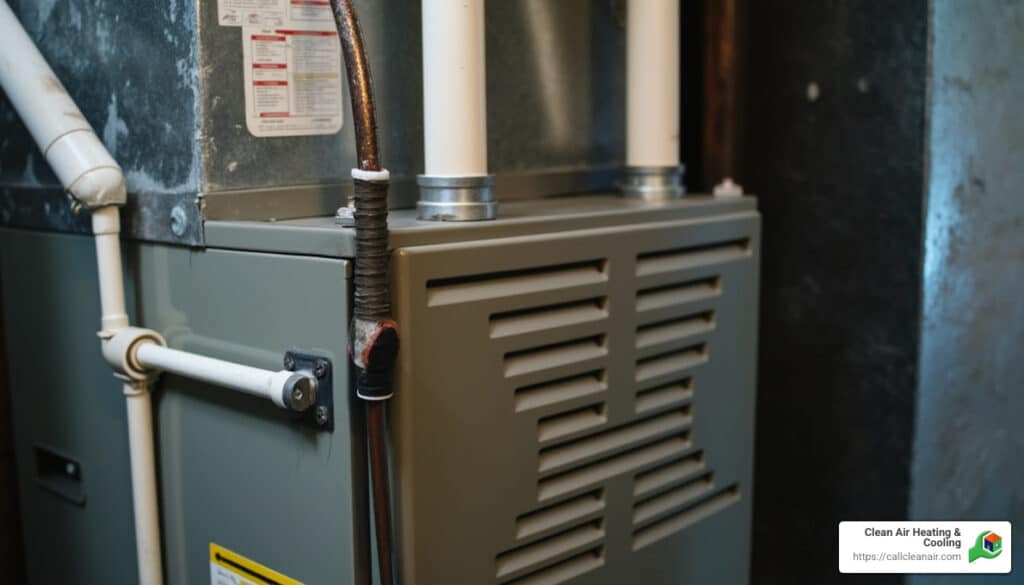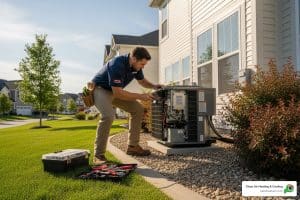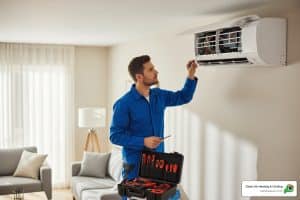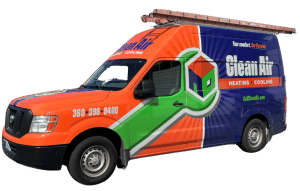Why High Efficiency Furnaces Are Essential for Pacific Northwest Homeowners
High efficiency furnace systems represent one of the smartest investments homeowners can make to reduce energy costs and improve comfort. According to the Department of Energy, heating your home typically represents about 45% of your utility bill – making furnace efficiency a critical factor in your monthly expenses.
What defines a high efficiency furnace:
- AFUE rating of 90% or higher (up to 98.5% maximum)
- Dual heat exchangers that capture waste heat
- Condensing technology that extracts additional heat from exhaust gases
- Advanced components like variable-speed blowers and modulating gas valves
- Energy Star certification for verified performance standards
High efficiency gas furnaces achieve their superior performance through innovative condensing technology. Unlike standard 80% AFUE units that lose 20% of fuel energy through exhaust, these advanced systems capture and use heat that would otherwise be wasted. This means more warmth for your home and significantly lower utility bills.
The benefits extend far beyond cost savings. Today’s high-efficiency models operate more quietly, provide more even heating throughout your home, and can even help reduce humidity during summer months when paired with cooling systems. For homeowners replacing older furnaces operating at just 56-70% efficiency, the improvement is dramatic.
As Colin Matei, Owner and President of Clean Air Heating & Cooling, I’ve helped countless homeowners in Bellingham and surrounding areas upgrade to high efficiency furnace systems that deliver exceptional comfort and energy savings. My experience has shown that the right high-efficiency system, properly installed and maintained, provides reliable performance while dramatically reducing heating costs for Pacific Northwest families.
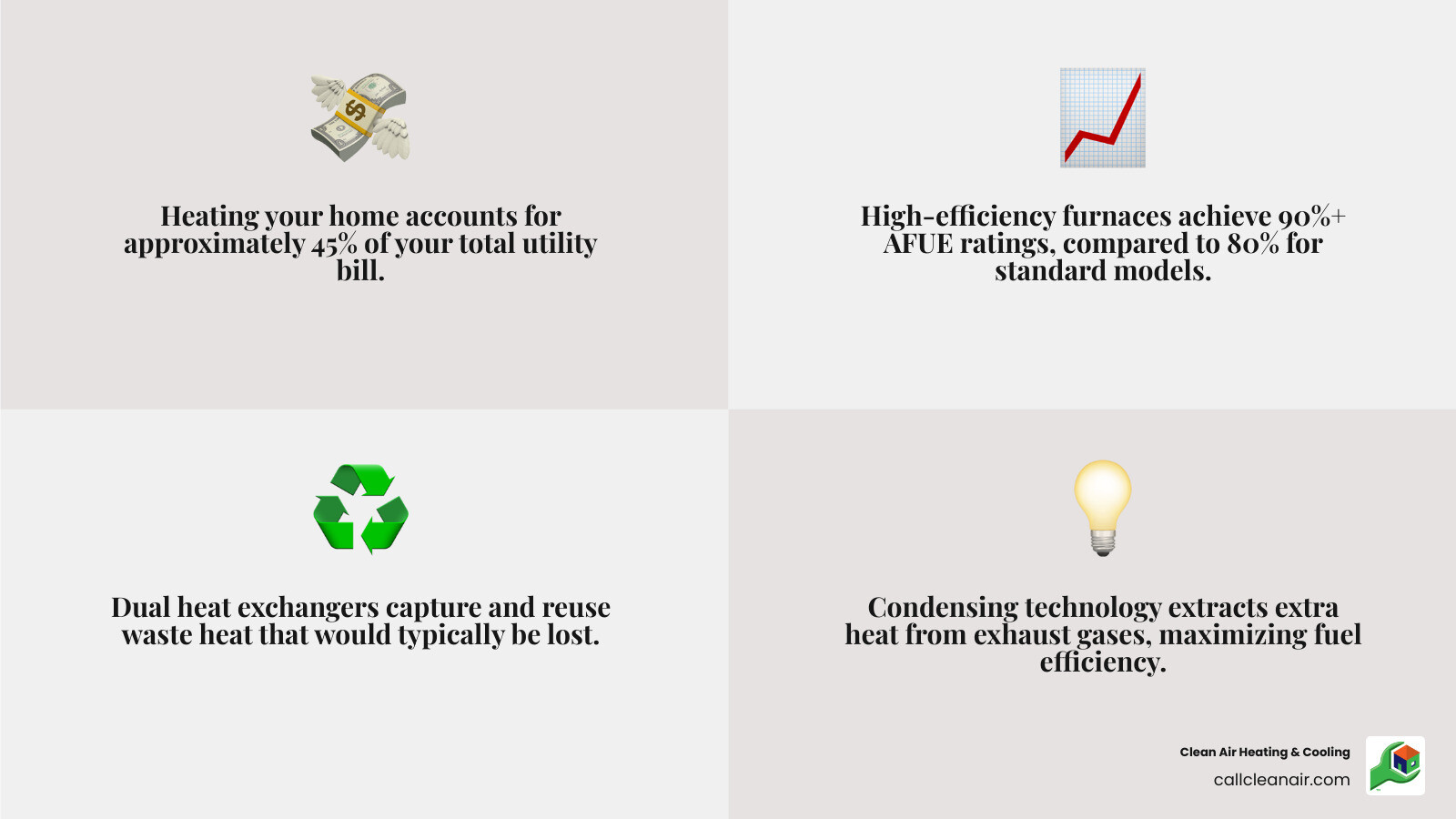
What Makes a Furnace “High-Efficiency”?
When shopping for a new heating system, you’ll encounter the term high efficiency furnace. This isn’t just marketing speak; specific standards and technologies separate these advanced units from standard-efficiency models, impacting both your comfort and your wallet.
A high efficiency furnace earns its title through smart engineering and rigorous testing. The most important factor is an AFUE rating of 90% or higher, but that’s just the start. These advanced furnaces use condensing technology to capture heat that would normally escape and are packed with advanced components like variable-speed blowers. To ensure you’re getting a truly efficient system, look for Energy Star certification. Many also feature sealed combustion, which draws outside air for burning fuel instead of using heated indoor air.
For more details about our comprehensive heating solutions, check out our furnace services page.
Understanding AFUE: The Key to Furnace Efficiency
Annual Fuel Utilization Efficiency (AFUE) is a rating that measures what percentage of fuel is converted into heat for your home versus how much is wasted. An 80% AFUE rating means 80 cents of every fuel dollar heats your home, while 20 cents is wasted.
Standard-efficiency furnaces operate at around 80% AFUE. This means a significant portion of your heating costs are lost, which adds up quickly during our Pacific Northwest winters.
High-efficiency furnaces start at 90% AFUE and can reach up to 98.5%. This 10-18.5% improvement over a standard unit translates to what these percentages mean for your wallet: significant savings, potentially hundreds of dollars annually. You can find the efficiency rating on the Yellow Energy Guide sticker on all new units, making it easy to compare models.
The ENERGY STAR Certified Furnaces database provides a complete list of qualifying models, making it simple to find efficient options.
The Technology Behind Superior Performance
A high efficiency furnace uses clever engineering to extract the maximum amount of heat from the fuel it burns. This impressive feat happens through a few key components.
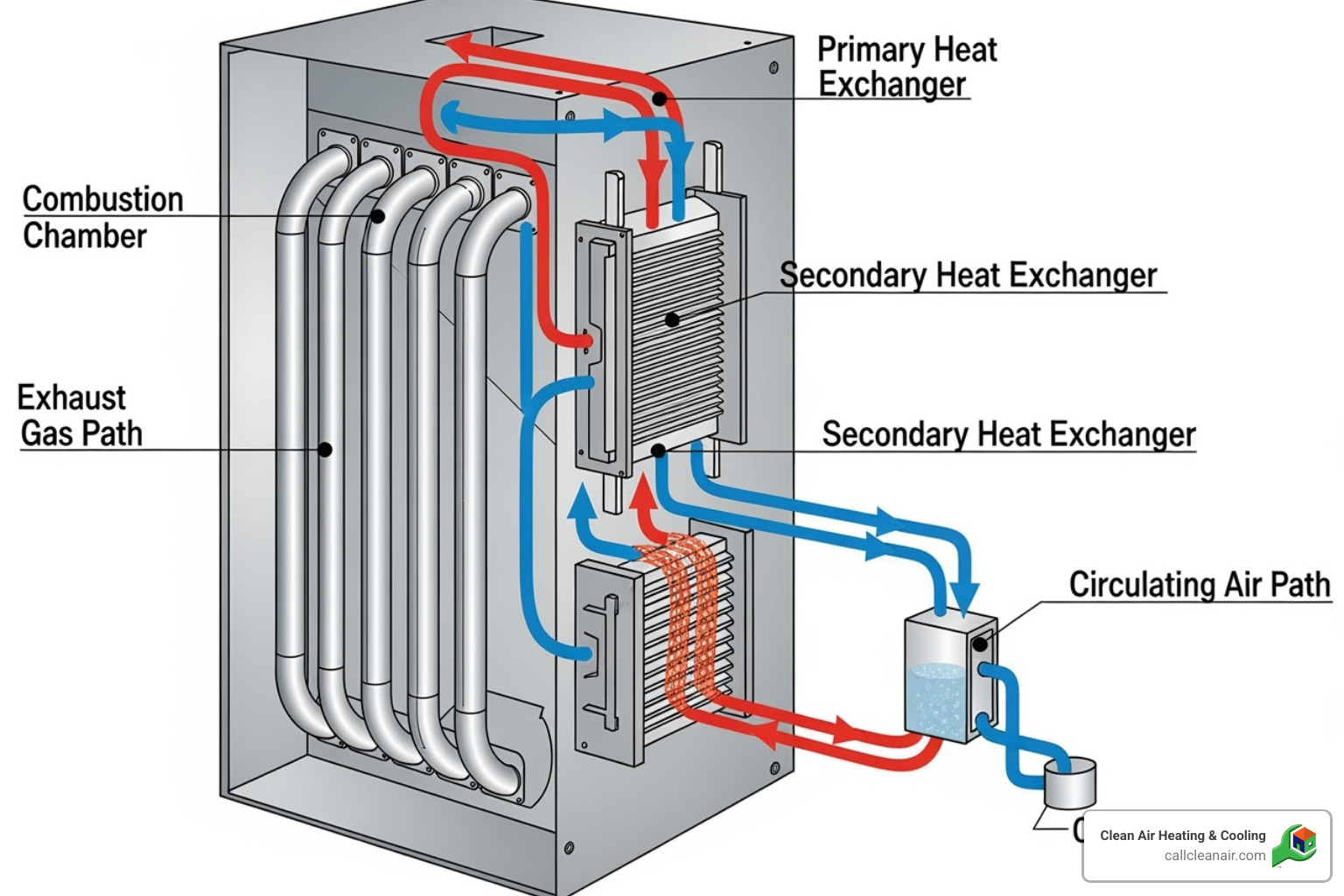
The primary heat exchanger captures the initial heat from burning fuel, just like in a standard furnace. The key difference is the secondary heat exchanger, which cools the hot exhaust gases until the water vapor condenses. This process of capturing waste heat releases additional warmth for your home.
Because the exhaust is cool and contains acidic moisture, these systems use PVC venting instead of a metal chimney. One pipe brings in fresh air for combustion, while the other removes the cool exhaust. The condensation is removed via a condensate drain.
Variable-speed blower motors improve comfort by adjusting their speed to deliver the right amount of heated air, resulting in consistent temperatures and quieter operation. Advanced systems also use modulating gas valves to fine-tune heat output, continuously adjusting the flame to match your home’s needs, saving energy and maximizing comfort.
The Tangible Benefits of Upgrading
Making the leap to a high efficiency furnace isn’t just about getting new equipment; it’s about changing your entire home experience while putting money back in your pocket. After helping hundreds of families across Whatcom, Skagit, Snohomish, and San Juan Counties upgrade their heating systems, I’ve seen how these benefits play out in real homes.
Significant Cost Savings on Your Utility Bills
With heating accounting for nearly half of your utility bill, improving furnace efficiency makes a real difference in your budget. Upgrading from an old 65-70% efficiency furnace to a 90%+ high efficiency furnace brings immediate savings. For example, replacing a 65% unit with a 92% model can save around $287 in the first year, totaling nearly $2,870 over a decade. A 94% efficient model could save over $3,000 in the same period.
While the initial investment is significant, the return on investment is clear as your high-efficiency system delivers savings year after year. For comprehensive information about heating system efficiency, the Energy.gov website provides excellent resources. If you’re weighing upgrade costs against repair expenses, our furnace repair cost estimate can help you make an informed decision.
Improved Home Comfort and Air Quality
A high efficiency furnace also transforms your home’s comfort, eliminating cold spots and uneven temperatures.
Even heat distribution is achieved with advanced features like variable-speed blowers and modulating gas valves. These systems run longer at lower speeds, maintaining consistent temperatures throughout your home.
Quieter operation is another major benefit. With variable-speed technology and sound-absorbing insulation, some models reduce operating noise by 20% compared to older units.
A surprising perk is better humidity control in summer. When paired with your cooling system, the variable-speed blower can help your air conditioner remove more moisture from the air.
Finally, you’ll see improved indoor air quality. High-efficiency furnaces work best with high-quality filters that trap more dust, pollen, and other particles. Learn more with our guide on how furnace maintenance improves IAQ.
Rebates, Tax Credits, and a Smaller Carbon Footprint
Upgrading to a high efficiency furnace offers more than just savings and comfort; bonus incentives can make the investment even sweeter.
Federal tax credits and local utility rebates often reward homeowners for choosing ENERGY STAR certified equipment. These incentives, which were expanded by the Inflation Reduction Act of 2022, can help offset your initial investment. It’s always worth checking for current programs that may apply to your new system. The IRS FAQs for energy tax credits provide detailed information.
Reduced greenhouse gas emissions mean your upgrade benefits everyone. A high efficiency furnace burns fuel more completely, producing fewer emissions. This commitment to eco-friendly heating actively reduces your household’s environmental impact.
How to Choose the Right High Efficiency Furnace
Choosing the right high efficiency furnace requires careful consideration of your home’s unique needs, your comfort preferences, and the features that offer the best value. Professional guidance is key to this decision. For homeowners in the Bellingham area looking at replacement options, our furnace replacement page provides comprehensive information about the process.
Sizing Your High Efficiency Furnace Correctly for Your Home
Proper furnace sizing is a precise science where many homeowners make costly mistakes. It’s not about square footage alone or matching the old unit’s size; it requires professional expertise.
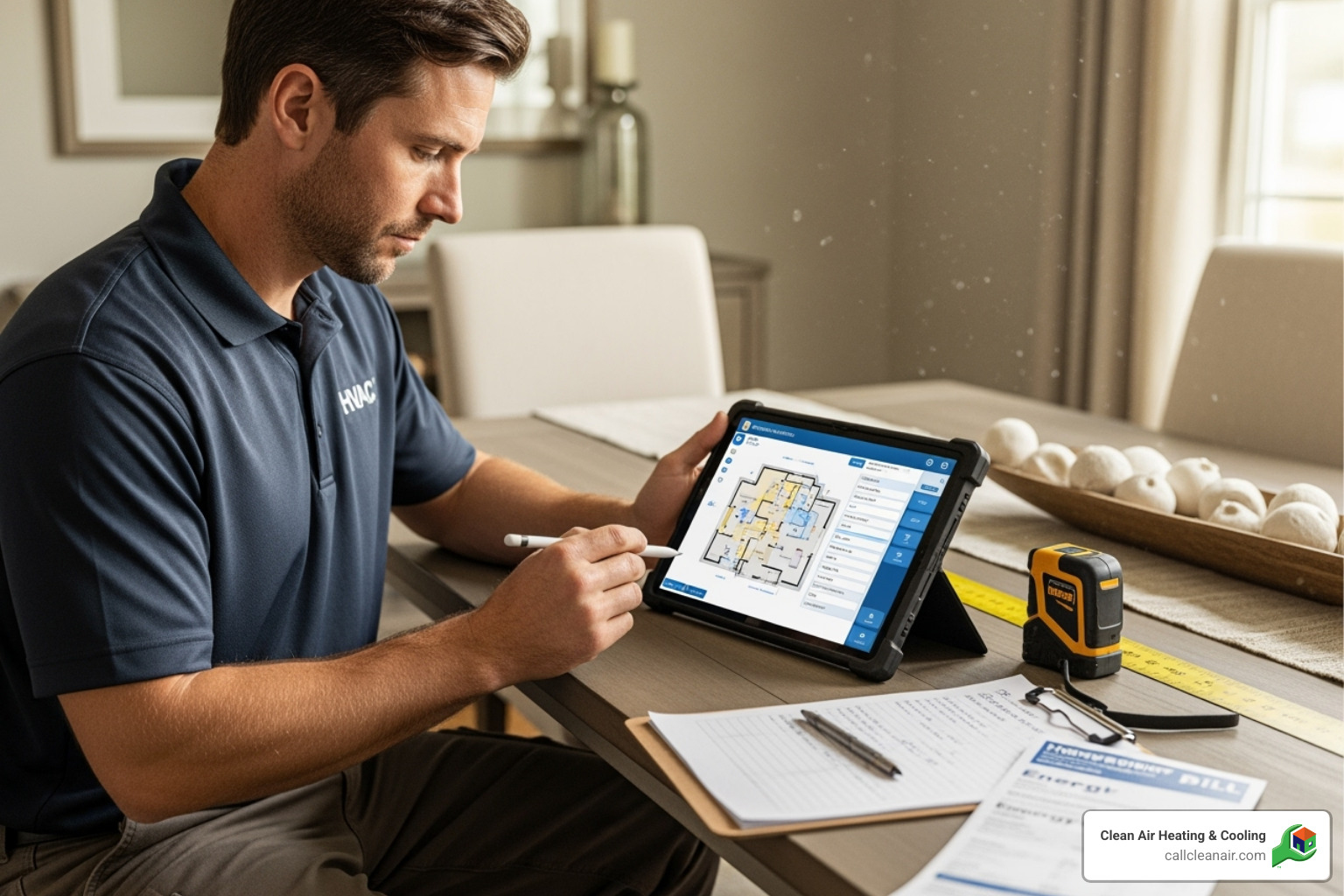
The dangers of getting sizing wrong are real. An undersized furnace will struggle to heat your home, while an oversized one will “short cycle”—constantly turning on and off. This wastes energy, causes uneven heating, and puts unnecessary stress on components.
The gold standard for proper sizing is called a Manual J load calculation. A qualified technician performs this comprehensive assessment, considering factors like your home’s insulation, windows, climate, ductwork, and layout—not just square footage. In our experience serving Whatcom, Skagit, and Snohomish Counties, we know that even similar homes can have vastly different heating needs.
Professional assessment is absolutely crucial for getting this right. A qualified HVAC technician can perform an accurate Manual J calculation to ensure you get optimal performance, maximum efficiency, and the comfort your family deserves. For expert installation services in the Everett area, check out our furnace installation in Everett, WA page.
Key Features to Look For in a Modern Unit
Once you’ve determined the right size, it’s time to explore the features that separate a good high efficiency furnace from a great one.
- Variable-speed blower motors are a must-have. They precisely adjust their speed to deliver the right amount of heated air, resulting in quiet operation, even temperatures, and better humidity control.
- Two-stage vs. modulating gas valves: Two-stage furnaces offer high and low settings for milder weather, while modulating furnaces offer even more precision by continuously adjusting heat output to perfectly match your home’s needs.
- Smart thermostat compatibility is key for modern control. These integrations allow for remote adjustments, custom scheduling, energy tracking, and even automated optimization.
- Other key features to look for include a durable ignition system for reliable startups, noise-reducing insulation, ENERGY STAR certification for guaranteed efficiency, advanced diagnostic features to simplify service calls, and home protection features like blocked-drain sensors to prevent water damage.
By focusing on these key features, you’ll select a high efficiency furnace that transforms your home’s comfort and provides peace of mind for years to come.
Lifespan and Maintenance for Peak Performance
Investing in a high efficiency furnace is a significant decision, and you want it to serve your family reliably for years to come. With proper care, these sophisticated heating systems are built to last. The secret to getting the most out of your investment is understanding what your furnace needs to perform at its best. If you’re currently experiencing any issues with your heating system, our furnace troubleshooting tips can help you identify common problems.
Maximizing Your Furnace’s Lifespan
A modern high efficiency furnace can last 15 to 20 years with proper maintenance. However, this lifespan depends heavily on how well the system is cared for. We’ve seen well-maintained furnaces last over two decades, while neglected ones may fail in as little as 10 years. Regular maintenance makes all the difference.
Think of maintenance as an insurance policy. Regular tune-ups catch small issues before they become expensive emergencies. Even the best-maintained furnaces eventually show their age. Watch for these warning signs that suggest it might be time to upgrade: frequent repair calls, climbing energy bills, strange noises, or rooms that won’t stay warm.
When repair costs start adding up, investing in a modern high efficiency furnace often makes more financial sense in the long run. For detailed guidance on extending your system’s life, check out our tips on how to extend the life of your furnace.
Essential Maintenance for Your High Efficiency Furnace
Maintaining your high efficiency furnace involves a combination of simple DIY tasks and annual professional care.
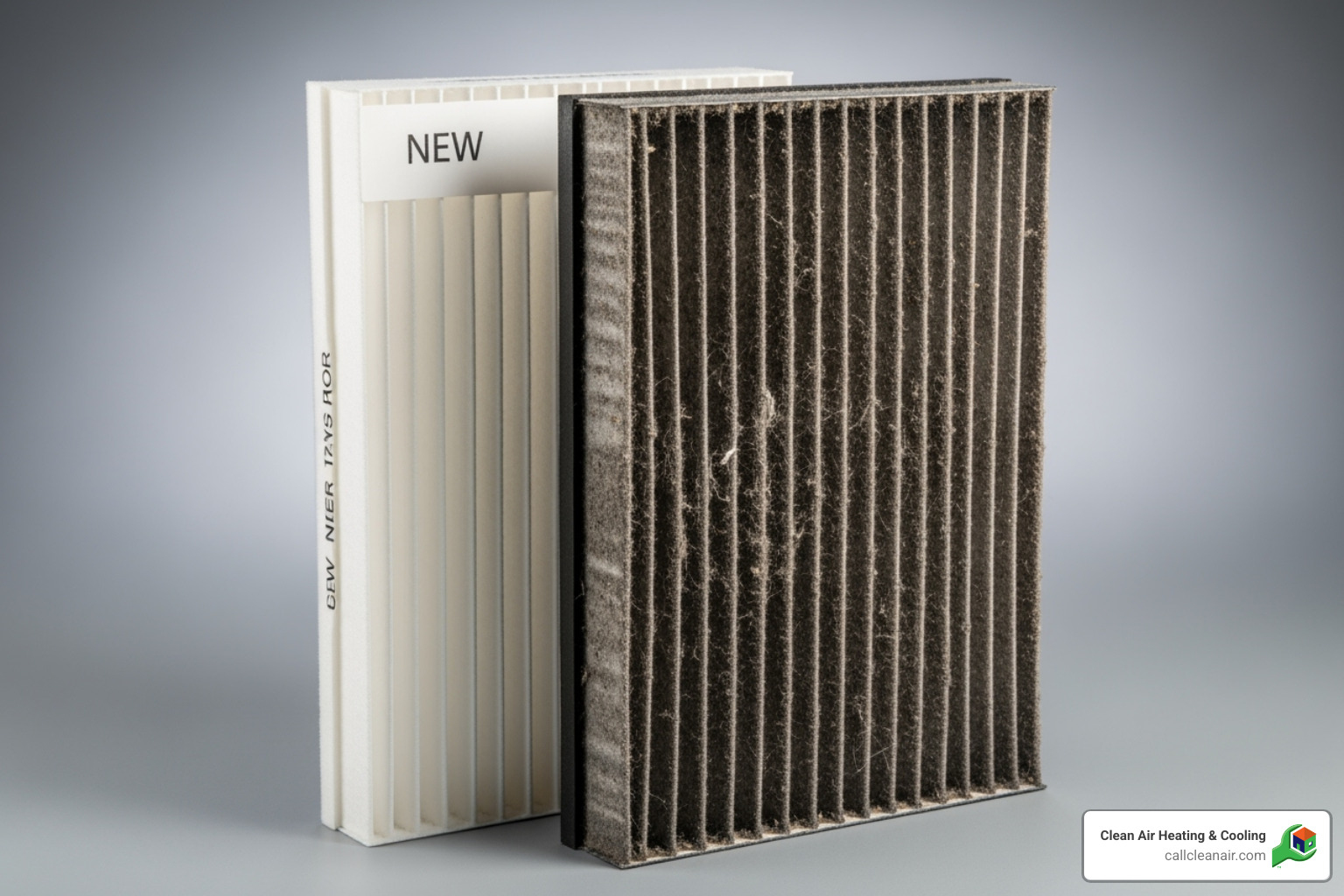
- Changing your air filter is the most important thing you can do. A dirty filter forces your system to work much harder. Check it monthly and replace it every 1-3 months to prevent costly repairs.
- Annual professional tune-ups are essential. A certified technician will clean key components, test safety controls, lubricate parts, and verify proper calibration and gas pressure.
- Keeping the condensate drain clear is crucial for a high efficiency furnace. These units produce moisture, and a clogged drain can cause a shutdown.
- Keeping your vents and registers unobstructed ensures your system has balanced airflow to work effectively.
Following these practices ensures your system operates at peak efficiency, keeping your energy bills low and your home comfortable. Our furnace maintenance checklist breaks everything down into manageable steps.
Frequently Asked Questions
Over the years, we’ve helped thousands of homeowners in Whatcom, Skagit, Snohomish, and San Juan Counties make the switch to high efficiency furnace systems. Here are the questions that come up most often.
How much can I really save with a high-efficiency furnace?
This is our most common question. Your actual savings depend on your old furnace’s inefficiency, local gas prices, and the severity of our Pacific Northwest winters. Typically, upgrading from an old 60-70% AFUE furnace to a modern high efficiency furnace with 95%+ AFUE can save you 25-35% on your heating bills. Since heating represents about 45% of your total utility costs, this is significant.
I’ve had homeowners call me after their first winter with a new system, genuinely surprised at how much lower their bills were. One family in Bellingham saved over $400 in their first heating season alone! The beauty is that these savings compound, making your investment pay for itself over time.
Do high-efficiency furnaces require special venting?
Yes, and the engineering is clever. Traditional furnaces use a metal chimney for hot exhaust, but a high efficiency furnace extracts so much heat that its exhaust is much cooler. This means they use two PVC pipes: one for fresh air intake and one for exhaust. Because the exhaust is cool and contains acidic condensate, PVC is the perfect corrosion-resistant material. This also provides more flexibility for installation, as we can often vent the furnace directly through a side wall of your home.
What are the signs that I need a new furnace?
Here’s what to watch for to know if your furnace is ready for retirement.
- Age is the biggest factor. If your furnace is over 15 years old, it’s time to consider a replacement. Older units are less efficient and lack the advanced features of a modern high efficiency furnace.
- Frequent repair calls are another red flag. If repairs are becoming common or costly, it’s often more economical to invest in a new system.
- Sudden spikes in your energy bills without any change in usage patterns usually mean your furnace is losing efficiency.
- Strange noises like banging, rattling, or squealing often indicate worn-out components that will only get worse.
- Inconsistent heating throughout your home suggests your furnace is struggling to distribute heat effectively.
If any of these sound familiar, give us a call. We’ll provide an honest assessment of whether repair or replacement makes the most sense for your situation.
Conclusion
Investing in a high efficiency furnace improves your home’s comfort while putting money back in your pocket. As we’ve covered, these remarkable systems can slash heating bills by 25-35%, deliver whisper-quiet operation, and provide even, consistent warmth.
The technology is impressive, from dual heat exchangers that capture waste heat to variable-speed blowers that fine-tune comfort. These sophisticated systems are designed for today’s energy-conscious homeowners who refuse to compromise on comfort.
However, the technology is only as good as the installation and ongoing care. Proper sizing through a Manual J calculation, professional installation, and regular maintenance are what transform a great furnace into an exceptional heating experience that lasts for decades.
The environmental benefits are also compelling. You reduce your home’s carbon footprint while potentially qualifying for valuable tax credits and utility rebates. It’s a win for the planet and your wallet.
For homeowners throughout Whatcom, Skagit, and Snohomish Counties, our certified technicians at Clean Air Heating & Cooling bring decades of experience to every installation. We understand the unique heating challenges of our Pacific Northwest climate and are committed to helping you find the perfect heating solution.
Don’t spend another winter wondering if your heating bills could be lower. Schedule your professional furnace assessment in Snohomish County today and find how a high efficiency furnace can transform your home’s comfort and energy costs.

